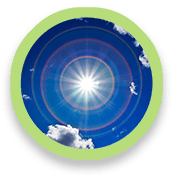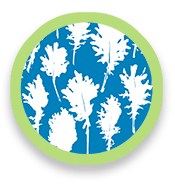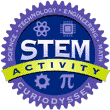SCIENCE EXPERIMENTS FOR KIDS
HOW TO MAKE SUN PRINTS
If you’ve got a hot second, try this fun activity that uses the sun to create art!
Here comes the sun! And it’s going to help you make some beautiful works of art with your kids that’ll give new meaning to “hot off the press.”
Using special sun print paper and gathered objects like sticks and leaves, your budding artists can create one-of-a-kind masterpieces while learning about chemical processes aided by the sun. Don’t forget the sunscreen! (For you and your child, not the artwork.)
GATHER THIS:
- Sun print paper
- Cardboard
- Cardboard cutting tool
- Clear plastic wrap or bag
- Tape
- Objects to cast a shadow on the sun print paper
- Bucket of water
THEN DO THIS:
- For best results, do this activity outside on a sunny day! Do not expose the sun print paper to direct sunlight until ready to print.
- Cut a cardboard frame larger than the sun print paper like an open window frame.
- Cut a piece of clear plastic wrap or plastic bag the same size as the cardboard frame.
- Tape the piece of clear plastic wrap or bag onto the cardboard frame, like a closed window.
- Gather object(s) you want to print on the sun print paper such as flowers, leaves, feathers, yarn, etc.
- In full shade, extract a piece of sun print paper. Place the sun print paper on another piece of cardboard to stabilize the objects while you put it in the sun.
- While in full shade, arrange the object(s) on the sun print paper.
- Put the water bucket in the shade.
- Put the sun print paper in the sun and the cardboard window over the sun print paper so your objects don’t blow away.
- Let stand for 1-2 minutes until the blue sun paper turns pale blue.
- Quickly submerge the sun print paper in the water bucket in the shade for around 1 minute.
- Lay flat to dry in the shade.
- Experiment on the sun print paper! Cut the sun print paper into small test papers and experiment on them. Test different variables such as exposure time, light source, water bath, time of day, etc.
- Don’t have sun print paper? No problem! Just do steps 2 – 5 and 9 on a piece of construction paper. Leave objects on the paper in full sun all day.
ASK THIS:
- Does the exposure time make a difference in the final blue color of the paper?
- Does the sun print paper work in different light sources? (LED, fluorescent, etc.)
- Does the amount of time soaking in the water make a difference in the final color?
- What happens if you try this activity at different times of the day or in different seasons?
- Does the temperature of the water make a difference in the final color?
- Does the sun print paper work if you get the paper wet first?
- How does the final color change if you move the objects slightly after sitting in the sun for a bit?
- Does a spherical object cast a shadow that is the same shape as the object?
WHAT IS HAPPENING?
The sun print paper is coated with a photo-sensitive chemical which reacts in light. The photo-sensitive paper turns pale blue when exposed to light. Water stops the chemical process and fixes the shadows of the objects on the sun print paper.
Sun print paper is coated on one side with a photo-sensitive chemical called iron (III) hexacyanferrate (III), Fe[Fe(CN)6], also known as Berlin Green.
Berlin Green is blueish-green and is water-soluble. When exposed to ultraviolet light (UV), a chemical reaction takes place where the water-soluble Berlin Green changes into a water-insoluble chemical called iron (III) hexacyanoferrate(II), Fe[Fe4(CN)6]3, also known as Prussian Blue.
When you submerge the paper in water, the water-soluble Berlin Green washes away, and the water-insoluble Prussian Blue remains fixed on the paper. The intensity of the Prussian Blue depends on the amount of time the paper is exposed to the light source and the intensity of the light source. For example, sun print paper doesn’t work nearly as well on a cloudy day as it does on a sunny day.
WHAT THIS TEACHES:
Skills: Cutting, taping, measuring, timing
Themes: Scientific process, chemical reactions, light energy
Join the CuriOdyssey Community
LOCATION
1651 Coyote Point Drive
San Mateo, CA 94401
Ohlone Land Acknowledgement
650-342-7755
info@curiodyssey.org
CuriOdyssey is a 501(c)(3) non-profit, Tax ID 94-1262434




